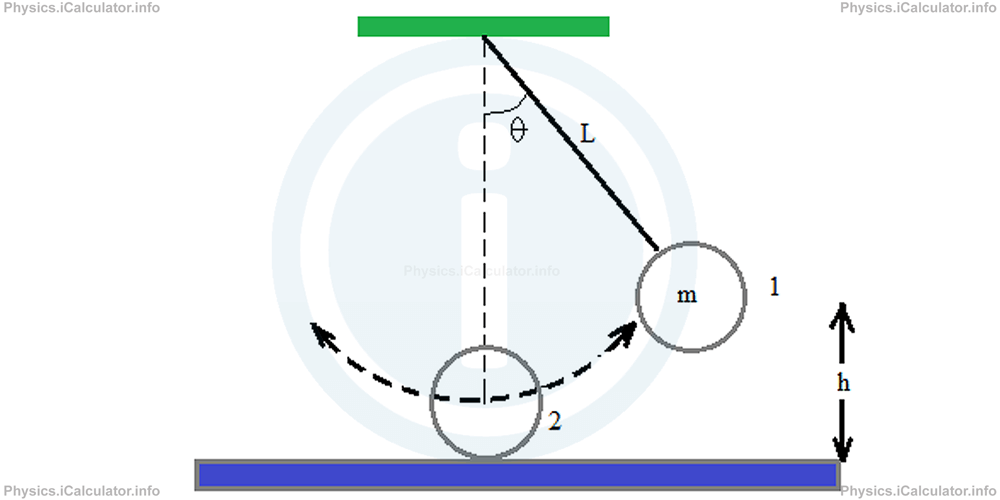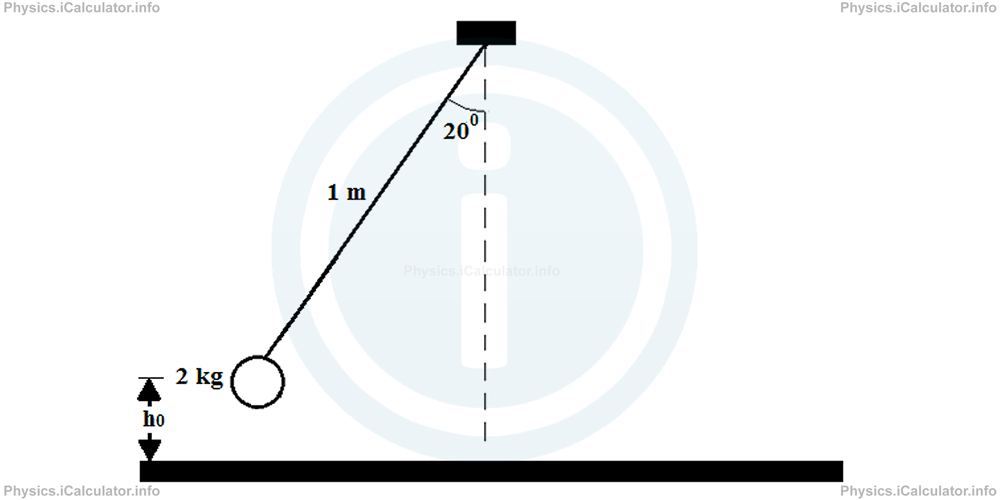Menu
Physics Lesson 10.2.5 - Energy in a Simple Pendulum
Please provide a rating, it takes seconds and helps us to keep this resource free for all to use
Welcome to our Physics lesson on Energy in a Simple Pendulum, this is the fifth lesson of our suite of physics lessons covering the topic of Pendulums. Energy in Simple Harmonic Motion, you can find links to the other lessons within this tutorial and access additional physics learning resources below this lesson.
Energy in a Simple Pendulum
To know the maximum speed and the highest position of the bob, we use the law of energy conservation. Thus, if considering the bob at position 1 at rest, it is obvious that its kinetic energy is zero. Therefore, since h = L - L × cos θ, we have

= Gravitational Potential Energy (1) + Kinetic Energy (1)
= Gravitational Potential Energy (1) + 0
= Gravitational Potential Energy (1)
= m × g × h
= m × g × (L - L × cos θ)
= m × g × L (1 - cos θ)
On the other hand, the kinetic energy is at maximum at the lowest point (position 2 or vertical position). In this position, gravitational potential energy is zero and all mechanical energy is due to kinetic energy. Thus, we can write
= Gravitational Potential Energy (2) + Kinetic Energy (2)
= 0 + Kinetic Energy (2)
= m × v2/2
These two energies are equal from the law of mechanical energy conservation. Thus, we can write
Simplifying mass we obtain,
Thus,
Or
After calculating v for known values of L and θ, we can find h as well, giving that
Example 2
A 2 kg bob is attached at the end of a 1 m thread as shown in the figure.

Calculate:
- Initial height h0 of the bob
- Period of this simple pendulum
- Height of the bob at t = 3.2 s
- Speed of the bob at t = 3.2 s
Take cos 200 = 0.94, sin 200 = 0.34 and g = 10 m/s2.
Solution 2
a The initial height h0 of the bob is
= L(1 - cos θ )
= 1 × (1-cos 200)
= 1 - 0.94
= 0.06 m
b The period of this pendulum is
= 2 × 3.14 × √1/10
≈ 2 s
c To calculate the height of the bob at a given time we must calculate the angle formed by the thread to the vertical at that specific time. for this, we use the equation of SHM for pendulums,
where t = 3.2 s, θ0 = 200 = π/9rad and ω = 2π/T = 2π/2 = π rad/s. Thus, we obtain
= π/9 × (-0.81)
= -0.283 rad
Thus, at t = 3.2 s, the object is at
= 1 - 1 × 0.96
= 0.04 m
d The speed of the bob at t = 3.2 s is calculated through the energetic method. Thus, since initially (at h0 = 0.06 m) the bob had only gravitational potential energy, the amount of mechanical energy of the bob during the entire motion is
m × g × h0 + 0 = m × g × h + m × v2/2
g × h0 = g × h + v2/2
10 × 0.06 = 10 × 0.04 + v2/2
0.6 = 0.4 + v2/2
v = √2 × (0.6 - 0.4)
= √0.4
= 0.63 m/s
You have reached the end of Physics lesson 10.2.5 Energy in a Simple Pendulum. There are 5 lessons in this physics tutorial covering Pendulums. Energy in Simple Harmonic Motion, you can access all the lessons from this tutorial below.
More Pendulums. Energy in Simple Harmonic Motion Lessons and Learning Resources
Whats next?
Enjoy the "Energy in a Simple Pendulum" physics lesson? People who liked the "Pendulums. Energy in Simple Harmonic Motion lesson found the following resources useful:
- Pendulum Energy Feedback. Helps other - Leave a rating for this pendulum energy (see below)
- Oscillations Physics tutorial: Pendulums. Energy in Simple Harmonic Motion. Read the Pendulums. Energy in Simple Harmonic Motion physics tutorial and build your physics knowledge of Oscillations
- Oscillations Revision Notes: Pendulums. Energy in Simple Harmonic Motion. Print the notes so you can revise the key points covered in the physics tutorial for Pendulums. Energy in Simple Harmonic Motion
- Oscillations Practice Questions: Pendulums. Energy in Simple Harmonic Motion. Test and improve your knowledge of Pendulums. Energy in Simple Harmonic Motion with example questins and answers
- Check your calculations for Oscillations questions with our excellent Oscillations calculators which contain full equations and calculations clearly displayed line by line. See the Oscillations Calculators by iCalculator™ below.
- Continuing learning oscillations - read our next physics tutorial: Simple Harmonic Motion
Help others Learning Physics just like you
Please provide a rating, it takes seconds and helps us to keep this resource free for all to use
We hope you found this Physics lesson "Pendulums. Energy in Simple Harmonic Motion" useful. If you did it would be great if you could spare the time to rate this physics lesson (simply click on the number of stars that match your assessment of this physics learning aide) and/or share on social media, this helps us identify popular tutorials and calculators and expand our free learning resources to support our users around the world have free access to expand their knowledge of physics and other disciplines.